The Bay Trail Preview: Intel Atom Z3770 Tested
by Anand Lal Shimpi & Brian Klug on September 11, 2013 12:00 PM ESTOur Windows performance analysis takes place on Intel's Bay Trail Form Factor Reference Design. The 10-inch tablet features a 2560 x 1440 display, 2GB of LPDDR3-1067 memory and a 64GB eMMC solution. The platform was running Windows 8.1 (32-bit).
Intel left me to install and run anything I wanted to during a period of a few hours at their campus in Santa Clara. I got a feel for the speed and snappiness of Bay Trail during my benchmark setup/installation process. While I don't believe Clover Trail was really usable in Windows 8's desktop mode (it was just too slow), the same is definitely not true for Bay Trail. With the exception of a few benchmark installs or loads that simply took forever, my Bay Trail experience was really quite good under Windows. Bay Trail is obviously not as fast as Haswell when it comes to general usage, but it's definitely worthy of a discussion. Whether or not it actually is good enough for an entry level machine will depend on how OEMs choose to configure their Bay Trail systems. I'll hold off on a final verdict here until we have some time with final Bay Trail devices and not just FFRDs.
Intel already teased the Atom Z3770's multithreaded Cinebench performance, but what about single threaded performance? Remember that single threaded performance is often a signfiicant contributor to things like application responsiveness.
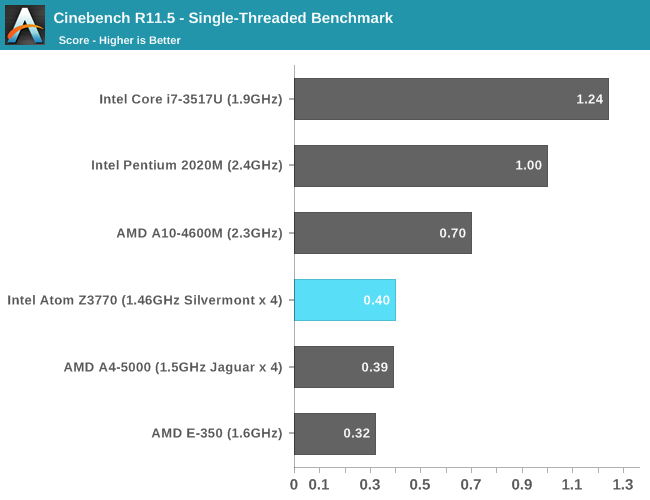
The single threaded performance numbers are just barely ahead of AMD's Jaguar based Kabini SoC. The big difference however is power. I had Intel measure SoC power at the board level while running a single threaded Cinebench 11.5 run on the Atom Z3770 and saw a range of 800mW - 1.2W. AMD on the other hand lists the A4-5000's SoC/APU idle power as 770mW. I don't have equivalent data for AMD, but with the A4-5000 idling at 770mW, it's safe to say that SoC level power consumption is lower on Bay Trail. The A10-4600M/Trinity comparison is interesting as it really helps put Bay Trail's performance in perspective as well.
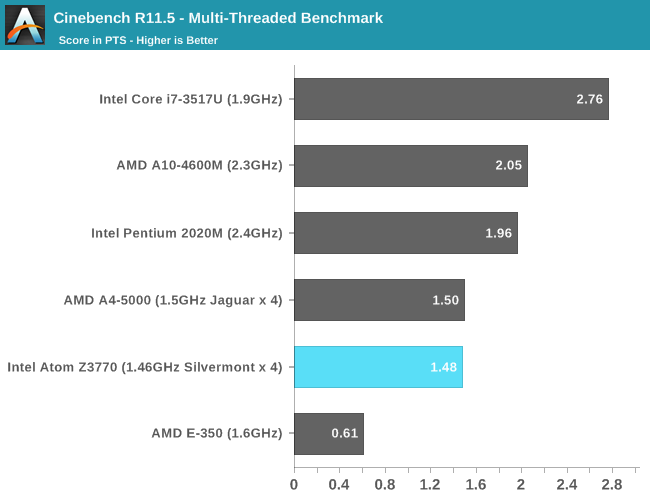
Multithreaded performance puts Bay Trail and AMD's Kabini at similar performance levels. Once again, looking at SoC power however the Atom Z3770 pulls around 2.5W in this test. Looking at the increase in platform power for the A4-5000 here, I'm assuming that the equivalent data for AMD would put Kabini in the 6W range. Multithreaded performance comes very close to the Pentium 2020M, but that's really overstating the strength of Bay Trail here as the Atom Z3770 has twice as many cores as the Pentium 2020M.
Single threaded integer performance is likely more useful to know, especially given Bay Trail's target market. For a rough idea of what to expect there, we turn to 7-Zip's built in benchmark. The dataset footprint is large enough to require main memory accesses, making this benchmark a little more interesting than it otherwise would've been. I unfortunately don't have access to all the CPUs here, so the 2C/4T 1.9GHz Core i7 3517U turns into a 2C/4T 1.7GHz Core i5 3317U as it's the only comparison data I had handy:
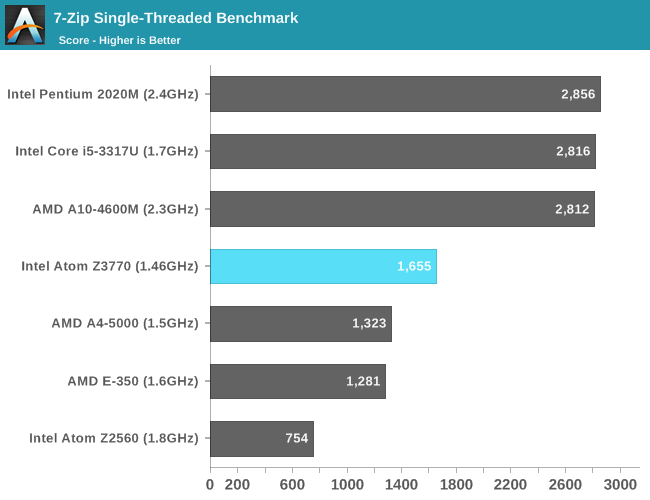
While Silvermont's single threaded FP performance seemed identical to Jaguar, its single threaded integer performance is much higher in the 7-Zip benchmark. Here the Atom Z3770 is 25% faster than the A4-5000. Looking further up the list however, there's still a healthy gap between thermally constrained Ivy Bridge Ultrabook class parts and the best Bay Trail has to offer. In this case Surface Pro's silicon is 70% faster than Bay Trail. Depending on your perspective that's either a huge difference or remarkably small given how wide the previous Atom to Core gap was.
7-Zip also features a multithreaded benchmark. Here we're looking at the same workload, but now split across all available cores/threads:
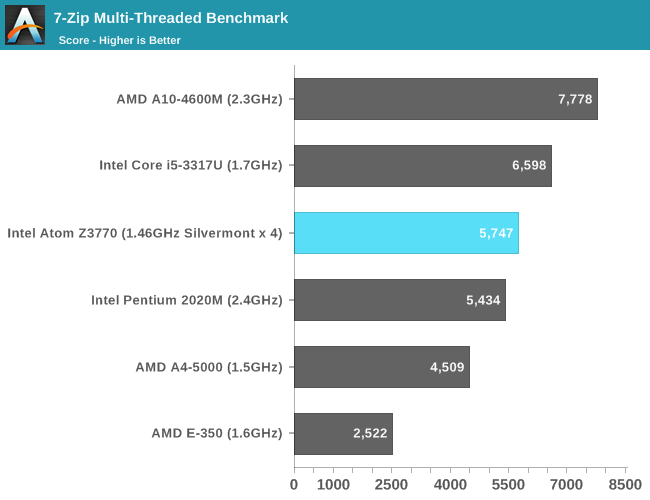
In multithreaded integer workloads, the Z3770 gets dangerously close to Ivy Bridge levels of performance. Again, we're overstating Bay Trail's performance here as the Z3770 has four cores while the Core i5-3317U only has two (but with Hyper Threading presenting another 2 virtual cores). I don't believe most tablet workloads are heavily threaded integer workloads, however the world is hardly single threaded anymore. The reality is that a quad-core Bay Trail should perform somewhere between 40% - 80% of a dual-core Ivy Bridge.
For what its worth, Bay Trail SoC power during the multithreaded 7-Zip benchmark was between 1.9W - 2.5W. At this point there's no question in my mind that Silvermont and Bay Trail are truly tablet-class power consumers.
Our next tests are browser based benchmarks that, once again, hope to characterize Bay Trail's performance in a manner that's more representative of lighter client workloads:
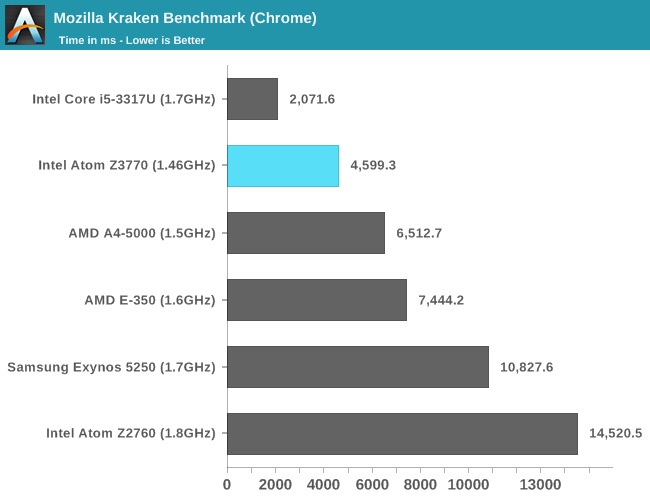
The Silvermont vs. Jaguar comparison shows a 29% advantage for Intel. Looking back at Clover Trail vs. Bay Trail, the performance improvement is staggering. Intel improved performance by over 3x at this point. The 17W Ivy Bridge vs. Bay Trail comparison continues to be interesting. Here the Core i5-3317U completes the Kraken test in half the time of the Atom Z3770.
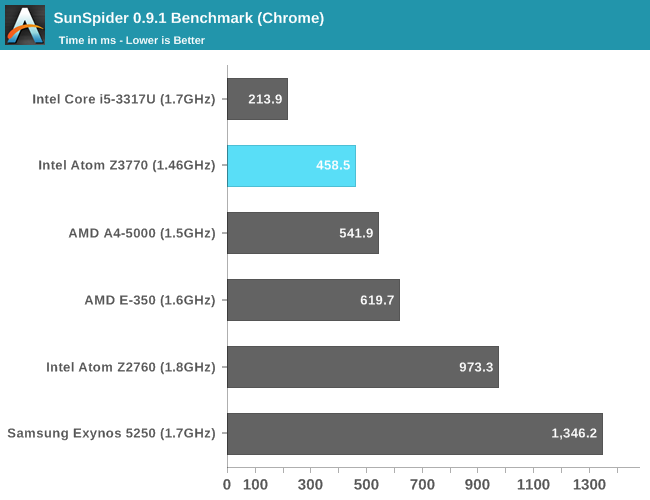
The Silvermont/Jaguar gap in SunSpider shrinks a bit in SunSpider. Bay Trail is still over 2x faster than Clover Trail, and Ivy Bridge remains over 2x the speed of Bay Trail.
For our final light CPU workload test we have PCMark 7. This is an interesting benchmark as it takes into account the storage subsystem a bit. Keep in mind here that the Bay Trail system is using eMMC based storage, while all of the others are using a standard SSD (Samsung SSD 830):
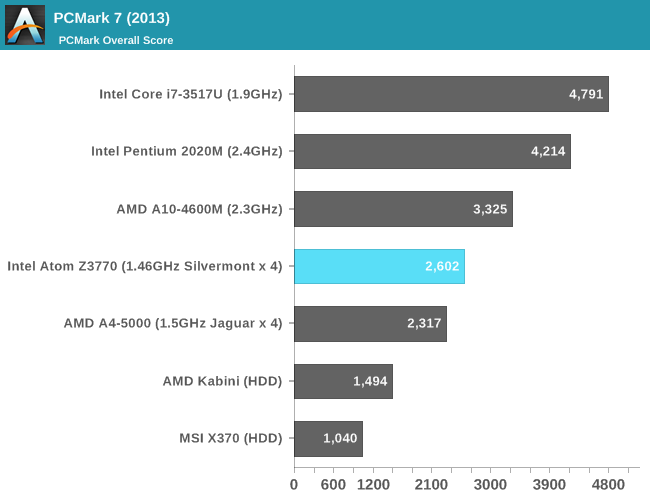
As we saw earlier, Bay Trail can make up for its single threaded performance by doing quite well in multithreaded tests. PCMark 7 attempts to present a mixed workload view of Bay Trail's performance and the result is relatively similar to AMD's Jaguar based A4-5000 Kabini APU. AMD's Trinity ends up being just under 30% faster than Bay Trail, while 17W Ivy Bridge is 60% faster. Overall platform performance is definitely not bad at all as long as the OEM does a good job specing the device. In this case the Samsung eMMC solution in the Bay Trail tablet reference design was surprisingly decent.
GPU Performance
Arguably the more interesting CPU and GPU tests will come in the Android section but I borrowed some Android data from our Kabini review and ran through 3DMark, GFXBench 2.7 and some lighter Steam games:
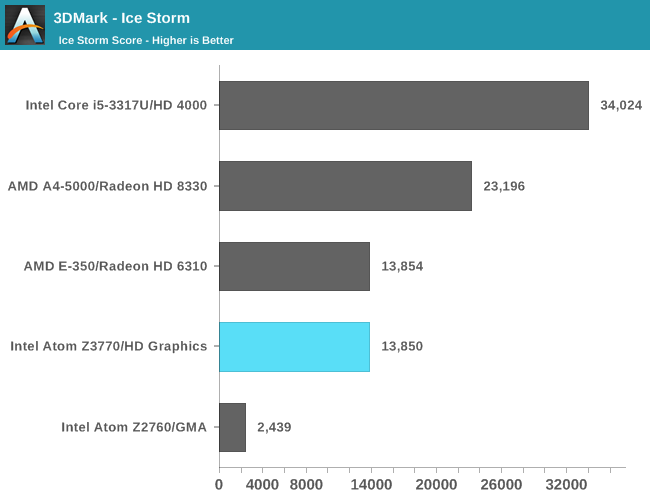
Bay Trail's overall 3DMark Ice Storm score (720p) is about on par with Brazos rather than being a competitor for Kabini. Bay Trail's HD Graphics core is based on Ivy Bridge and it's a cut down implementation at that.
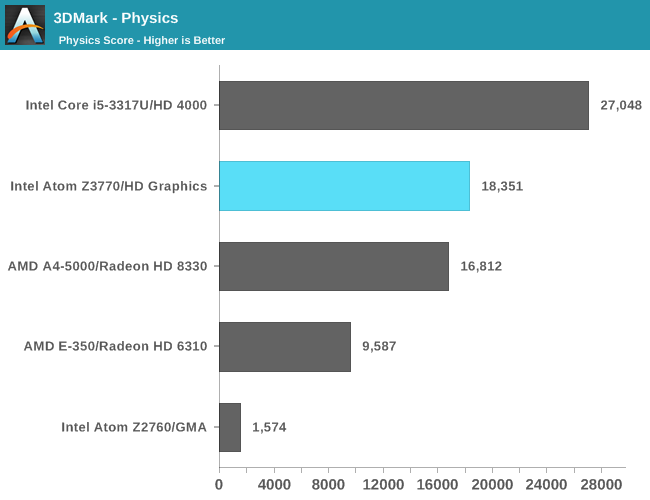
3DMark's Physics test is basically a multithreaded CPU benchmark, which allows the Z3770 to pull ahead of the A4-5000.
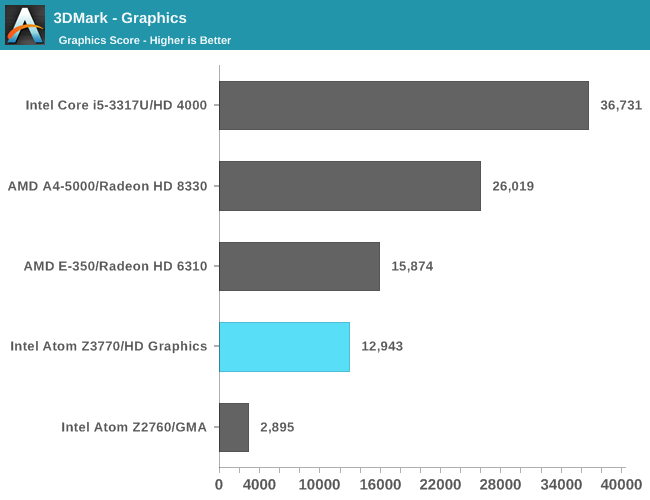
If we isolate graphics alone however, the Z3770 once again falls behind Brazos.
GFXBench 2.7's T-Rex HD test seems to agree with what 3DMark tells us:
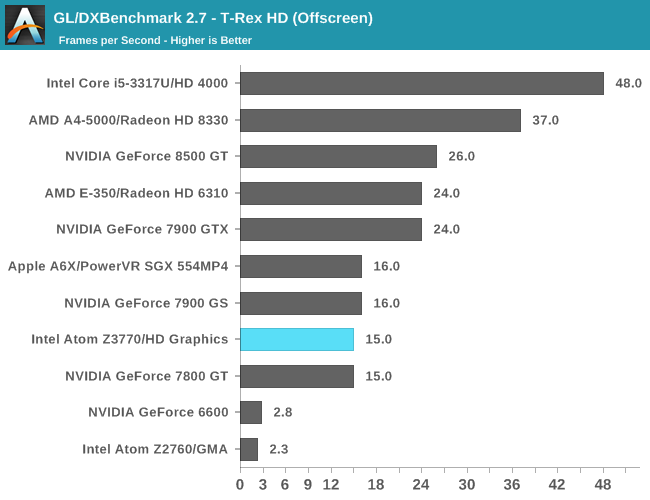
Obviously under Windows we have more opportunities to benchmark actual game performance. I turned to the lighter (1366 x 768, low quality) game benchmarks I ran for our HD 5000 comparison. I had to exclude Super Street Fighter IV as a driver problem kept it from running on the Bay Trail FFRD.
In a couple of cases Bay Trail delivers roughly half the GPU performance of a 2011 11-inch MacBook Air, but in a much lower power package. Minecraft saw a bigger gap at 1/3 the performance. None of these games are really playable, but that doesn't mean others aren't. I was able to play Team Fortress 2 on Intel's Bay Trail FFRD (with a Bluetooth keyboard and mouse of course) at reasonable frame rates. The system would chunk occasionally but for the most part it was relatively quick. Obviously Bay Trail's graphics are better suited for lighter tablet games.
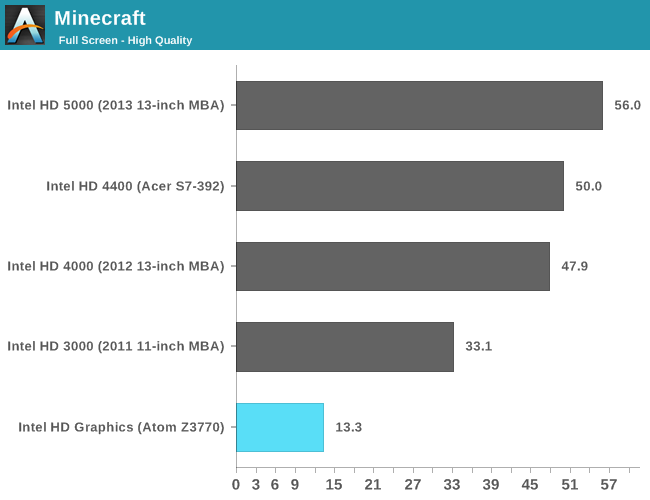












190 Comments
View All Comments
ancientarcher - Friday, September 13, 2013 - link
well, there are two different things here1) whether it costs less vs clovertrail or is it just that the pricing is different: Clovertrail was on the 32nm fab, which is 4-6 years old by now, whereas 22nm trigate is only 2 years old. Apart from the age of the fab, double patterning matters - it means that you have double the number of steps as single patterning (in same stages). Even for relatively old fabs, double patterning will increase costs. Trigate also adds cost, not least in testing. I would bet my last penny that Baytrail is more expensive to manufacture than clovertrail, but Intel is pricing it lower (meaning lower margin) to not repeat past mistakes. Pricing Baytrail at $100+ will mean missing the market altogether, no matter how good the chip is.
&
2) costs versus the core series is irrelevant. The final costs depend primarily on the area of the chip. But Intel hasn't given out any details. WHY??? might I ask. Given the amount of graphics power and cores (4 vs 2 in clovertrail), I would think that the area of the Baytrail might be closer to 100mm^2. So, yea the core i7 processor of 177mm^2 is much larger but sells for $450 retail. Big difference...
By the time Intel is readying to put these in a smartphone, Qualcomm and the others will have products in 20nm (planar) with at least ~30% increase to CPU and GPU (maybe more in GPU on HSA capability) and Intel will fall behind again.
FAIL!!
zeo - Saturday, September 14, 2013 - link
Sorry but you lose the cost bet, for one thing you're forgetting the 22nm FAB reduces the amount of material needed for each chip and they can put more units on each wafer! So mass produced the cost of things like Tri-Gate get absorbed and negated... The increase in cost is also less now than when they first introduced the 22nm FAB. This isn't new technology anymore and the FAB yields are high enough to reduce costs now!Simple fact of the matter is we're already seeing pricing announced for Bay Trail based devices and they're starting well below what Clover Trail devices were introduced at!
The Asus T100 only has a starting price of $349, PCMag even did a benchmark (something to do with matching names and addresses using an algorithm), which took Clover Trail over 30 minutes but the Z3740 in the T100 finished it in just over 15 Minutes... and it includes the Keyboard dock in the pricing!
So the lower pricing and higher performance is a reality!
And no, Intel will already be putting these in Smart Phones by the time Qualcomm and others will have products in 20nm in actual products! Merrifield is getting a early 2014 release and besides, by the time they do push out 20nm into actual products Intel will already be getting ready to push out their 14nm Airmont update, which they already put on a accelerated schedule for rollout!
Really, it's understandable to be pessimistic, Intel took over 5 years to get serious with both mobile and the ATOM but believe it or not they're finally serious about it...
ollienightly - Sunday, September 15, 2013 - link
This is just silly. Intel already put almost twice as much transistors as CT+ in BT-T. The die size should be similar, thus invalidate your whole point of being cheaper. 32nm was back then much older tech than 22nm now. 32nm began shipping back in Q4 2009, CT was some 3-years later. Assuming BT-T ships this year, there's only a 2-year gap since intel's first 22nm offerings. So neither die size nor maturity is on BT-T's side. And the sheer cost in moving to 22nm will be the deciding factor. I wouldn't be surprised if the silicon costs twice as much to make and the total cost is 30% higher.Pricing has NOTHING to do with cost itself. BT-T is priced lower to remain competitive, that's all. Case in point, Haswell 4C-GT2 (177mm2, 4702M@2.2GHz) is more expensive than Haswell 2C-GT3 (181mm2, 4600M@2.9GHz), that is with the same process, TDP, time to market. And higher frequency / bigger die has higher defection rate. So there goes your cost theory.
zeo - Sunday, September 15, 2013 - link
Ship this year?Really? Toshiba, Dell and Asus are shipping Bay Trail based products in just over a month and you're still on whether they'll ship this year!
ollienightly - Sunday, September 15, 2013 - link
Also, keep in mind NVIDIA claims the per transistor cost stopped being competitive beyond 28nm-node. The general trend holds true for Intel. Even more so in CT v BT-T case since 22nm is still young whereas when CT announced, 32nm HKMG was widely used by every FAB in the world.zeo - Sunday, September 15, 2013 - link
Nonsense, first 22nm was started longer than 2 years ago. It only began producing shipping products 2 years ago but they were working on the technology much longer than that and it doesn't take long to perfect, which they have to do before they seriously move on to the next FAB advancement and they're already starting to get ready for that as well!Really, Intel is way ahead on many of these technologies. For example, Intel had been using HKMG at 45nm, long before ARM manufacturers caught up at 32nm, and Tri-Gate is already a well developed technology for Intel. Also, Bay Trail is a much simpler chip than the Core Processors. So it's doesn't require as high precision to make as the much more complex Core processors and thus they are a lot easier to get good yields for them!
And again, my point is the prices of actual devices coming out with Bay Trail is lower than the previous Clover Trail... So regardless of what you think Bay Trail is in fact cheaper than Clover Trail!
Not to mention Intel stated this months ago that Bay Trail will be cheaper than Clover Trail! Actual product pricing shows they kept their word!
monstercameron - Friday, September 13, 2013 - link
wow, do some research dude, oems don't care about power, case-in-point acer w700 and all those other i3/i5 tablets [ivybridge]. The a4-5000 could fit in a tablet just as comfortably.Nagorak - Wednesday, September 11, 2013 - link
In that case, why not just hold out for a Haswell based tablet?lmcd - Wednesday, September 11, 2013 - link
I still wonder what the picture would be like with comparable graphics. Too bad the wait still isn't over. And imagine what happens when Jaguar hits the HPL process Qualcomm got access to.Homeles - Wednesday, September 11, 2013 - link
Jaguar is on GloFo. Snapdragon 800 is on TSMC.